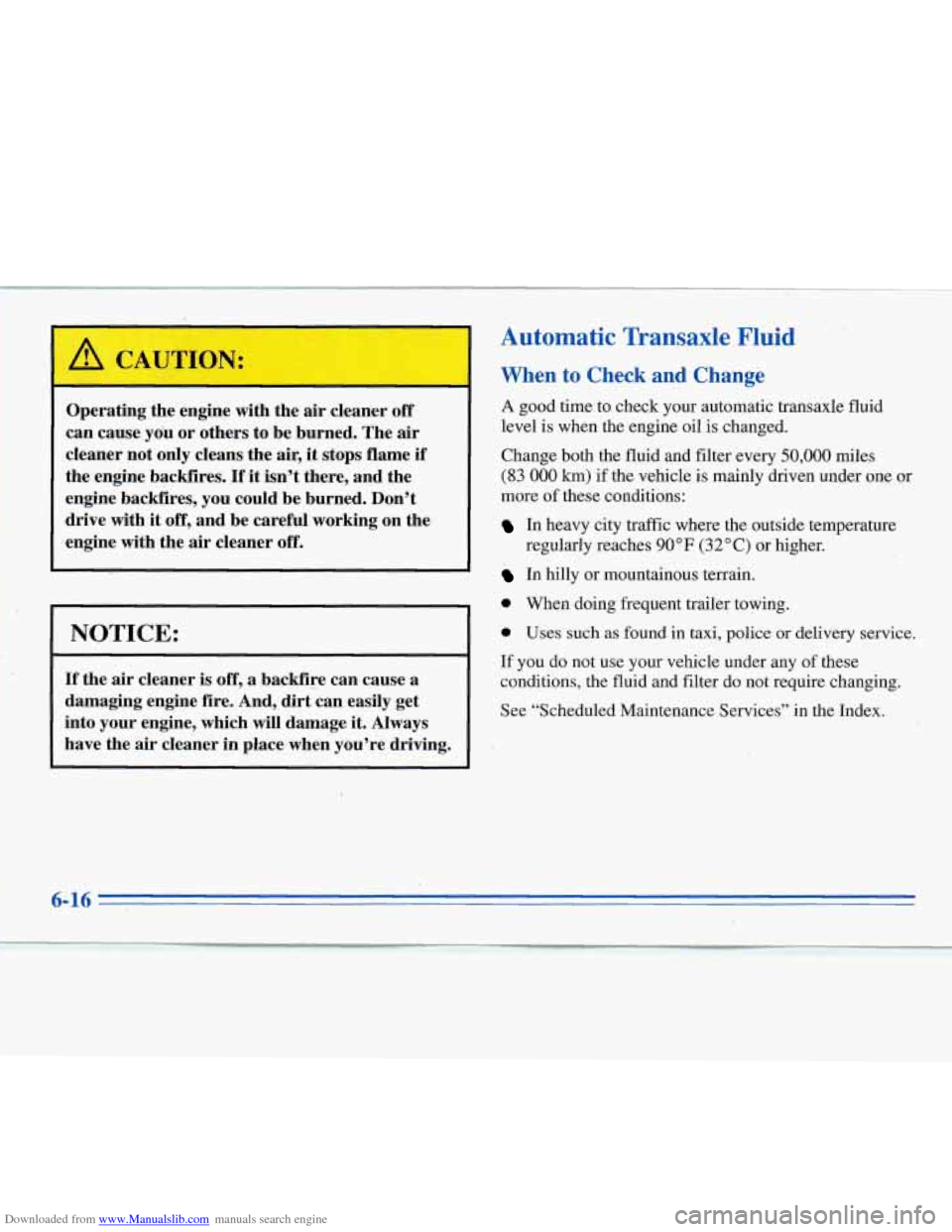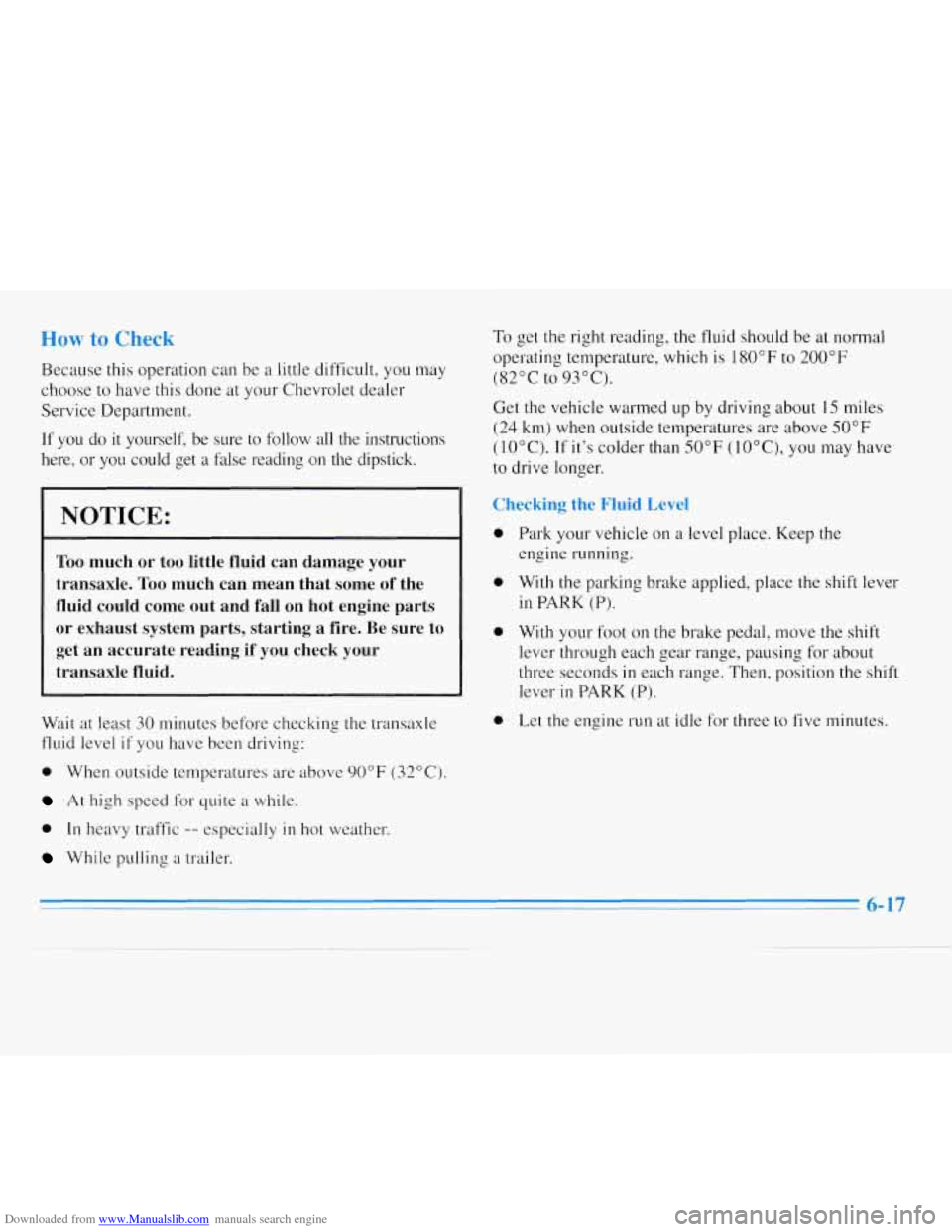Page 223 of 340
Downloaded from www.Manualslib.com manuals search engine Air Cleaner
To check or replace the air filter, remove the four screws
and pull
off the cover. Pull
out the filter. Be sure to install the air filter and
install the cover tightly when you are finished.
Refer to the Maintenance Schedule to determine when to
replace the air filter.
See “Scheduled Maintenance Services”
in the Index.
6-15
Page 224 of 340

Downloaded from www.Manualslib.com manuals search engine -
,A CAUTION:
Operating the engine with the air cleaner off
can cause you or others to be burned. The air
cleaner not only cleans the air, it stops flame if
the engine backfires. If it isn’t there, and the
engine backfires, you could be burned. Don’t
drive with
it off, and be careful working on the
engine with the
air cleaner off.
NOTICE:
If the air cleaner is off, a backfire can cause a
damaging engine fire. And, dirt can easily get
into your engine, which will damage it. Always
have the air cleaner in place when you’re driving.
Automatic Transaxle Fluid
When to Check and Change
A good time to check your automatic transaxle fluid
level is when the engine oil is changed.
Change both the fluid and filter every
50,000 miles
(83 000 km) if the vehicle is mainly driven under one or
more
of these conditions:
In heavy city traffic where the outside temperature
In hilly or mountainous terrain.
0 When doing frequent trailer towing.
0 Uses such as found in taxi, police or delivery service.
If you do not use your vehicle under any of these
conditions, the fluid and filter do not require changing.
See “Scheduled Maintenance Services’’ in the Index.
regularly reaches
90°F (32°C) or
higher.
6-16 .
Page 225 of 340

Downloaded from www.Manualslib.com manuals search engine How to Check
Because this operation can be a little difficult, you may
choose to have this done at your Chevrolet dealer
Service Department.
If you do
it yourself, be sure to follow all the instructions
here, or you could get
a false reading on the dipstick.
NOTICE:
Too much or too little fluid can damage your
transaxle.
Too much can mean that some of the
fluid could come out and fall
on hot engine parts
or exhaust system parts, starting a fire. Be sure to
get an accurate reading if
you check your
transaxle fluid.
Wait at least 30 minutes before checking the transaxle
fluid level
if you have been driving:
0 When outside temperatures are above 90°F (32°C).
At high speed for quite a while.
0 11-1 heavy traffic -- especially in hot weather
While pulling a trailer.
To get the right reading, the fluid should be at normal
operating temperature, which is
180°F to 200°F
(82°C to 93°C).
Get the vehicle warmed up by driving about 15 miles
(24 km) when outside temperatures are above 50°F
(10°C). If it's colder than 50°F (lO"C), you may have
to drive longer.
Checking the Fluid Level
0
0
0
e
Park your vehicle on a level place. Keep the
engine running.
With the parking brake applied, place the shift lever
in PARK (P).
With your foot on the brake pedal, move
the shift
lever through each gear range, pausing for about
three seconds in each range. Then, position the shift
lever
in PARK (P).
Let the engine
run at idle for three to five minutes.
6-17
Page 226 of 340
Downloaded from www.Manualslib.com manuals search engine Then, without shutting off the engme, follow these steps:
3.1
L L82 (Code M) Engine 3.4L LQl (Code X) Engine
1, The
transaxle fluid dipstick handle is the red loop
near the back
of the engine. Pull out the dipstick and
wipe
it with a clean rag or paper towel.
2. Push it back
in all the way, wait three seconds and
then pull it back out again.
3.1 L L82 (Code M) Engine 3.4L LQI. (Code X) Engine
3. Check both sides
of the dipstick, and read the
lower level. The
fluid level must be in the
cross-hatched area.
4. If the fluid level is in the acceptable range, push the
dipstick back in all the way.
4-18
Page 227 of 340

Downloaded from www.Manualslib.com manuals search engine How to Add Fluid Engine Coolant
Refer to the Maintenance Schedule to determine what
kind
of transaxle fluid to use. See “Recommended
Fluids and Lubricants”
in the Index.
If the fluid
level is low, add only enough of the proper
fluid to bring the level into the cross-hatched area on
the dipstick.
1. Pull out the dipstick.
2. Using a long-neck funnel, add enough fluid at the
dipstick hole to bring
it to the proper level. It doesn’t
take much fluid, generally less than
a pint (OSL).
Don ’t overfill. We recommend you use only fluid
labeled DEXRON@-111, because fluid with that
label is made especially for your automatic transaxle.
Damage caused by fluid other than DEXRON@-I11
is
not covered by your new vehicle warranty.
0 After adding fluid, recheck the fluid level as
described under “How to Check.”
0 When the correct fluid level is obtained, push the
dipstick back
in all the way. The cooling
system in your vehicle is filled with new
DEX-COOL
TM (orange-colored, silicate-free) engine
coolant. This coolant is designed
to remain in your
vehicle for
5 years or 100,000 miles ( 166 000 km),
whichever occurs first.
The following explains your cooling system and how
to
add coolant when it is low. If you have a problem with
engine overheating
or if you need to add coolant to your
radiator, see “Engine Overheating”
in the Index.
A 50/50 mixture of water and the proper coolant for
your Chevrolet will:
0 Give freezing protection down to -34°F (-37°C).
0 Give boiling protection up to 265°F (129°C).
Protect against rust and corrosion.
0 Help keep the proper engine temperature.
0 Let the warning lights and gages work as they
should.
Page 229 of 340
Downloaded from www.Manualslib.com manuals search engine NOTICE:
If you use an improper coolant mix, your
engine could overheat and be badly damaged.
The repair cost wouldn’t be covered by your
warranty.
Too much water in the mix can freeze
and crack the engine, radiator, heater core and
other parts.
If you have to add coolant more than four times a year,
have your dealer check your cooling system.
I NOTICE:
If you use the proper coolant, you don’t have to
add extra inhibitors or additives which claim to
improve the system. These can be harmful.
Checking Coolant
r-
When your engine is cold, the coolant level should be at
the
COLD mark or a little higher. When .your engine is
warm,
the level should be up to the HOT mark or a
little higher.
6-21
Page 231 of 340

Downloaded from www.Manualslib.com manuals search engine Radiator Pressure Cap Power Steering Fluid
NOTICE:
Your radiator cap is a 15 psi (105 kPa)
pressure-type cap and must be tightly installed
to prevent coolant
loss and possible engine
damage from overheating. Be sure the arrows
on the cap line up with the overflow tube on
the radiator filler neck.
When you replace your radiator pressure cap, an AC@
cap is recommended.
Thermostat
Engine coolant temperature is controlled by a thermostat
in the engine coolant system. The thermostat stops the
flow of coolant through the radiator until the coolant
reaches a preset temperature.
When you replace your thermostat, an AC@ thermostat
is recommended.
3.1L L82 (Code M) Engine 3.4L LQI (Code X) Engine
When to Check Power Steering Fluid
It is not necessary to regularly check power steering
fluid unless you suspect there is a leak
in the system or
you hear an unusual noise. A fluid loss-in this system
could indicate a problem. Have the system inspected
and repaired.
6-23
Page 232 of 340
Downloaded from www.Manualslib.com manuals search engine How To Check Power Steering Fluid Windshield Washer Fluid
When the engine compartment is cool, unscrew the cap
and wipe the dipstick with a clean rag. Replace the cap
and completely tighten it. Then remove the cap, again
and look at the fluid level on the dipstick.
When the engine
compartment is hot, the
What to Use
Refer to the Maintenance Schedule to determine what
kind of fluid to use. See “Recommended Fluids and
Lubricants” in the Index. Always use the proper fluid.
Failure to use the proper fluid can cause leaks and
damage hoses and seals.
What to Use
When you need windshield washer fluid, be sure to read
the manufacturer’s instructions before use. If you will be
operating your vehicle
in an area where the temperature
may fall below freezing, use a fluid that has sufficient
protection against freezing.
Adding Washer Fluid
Open the cap labeled WASHER FLUID OmY. Add
washer fluid until the tank is full.